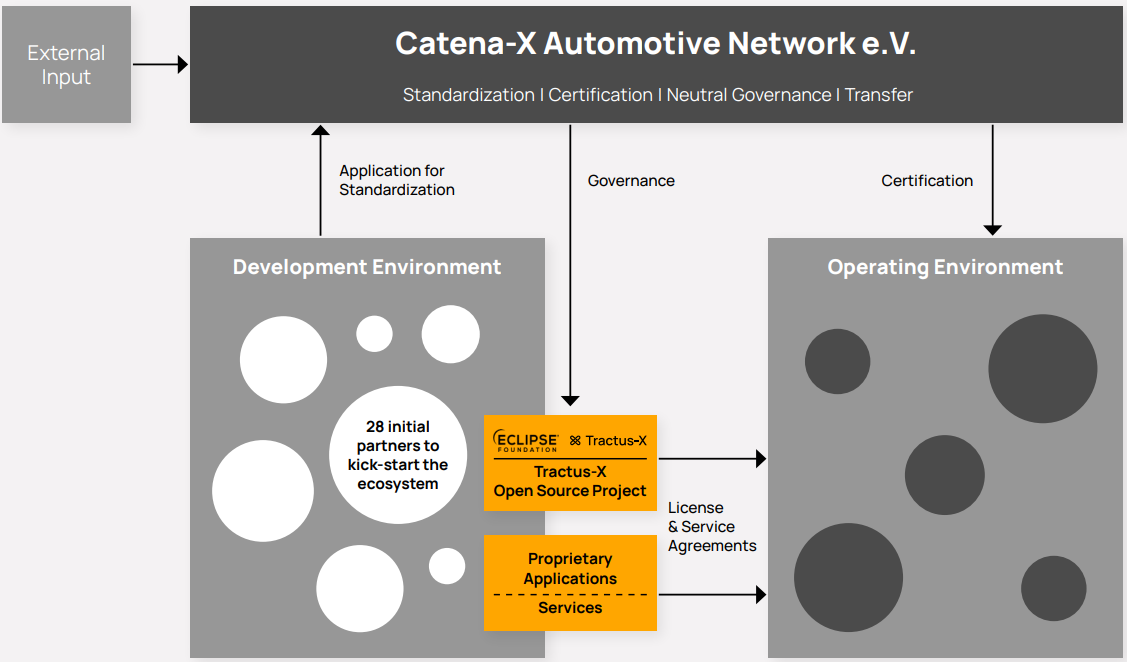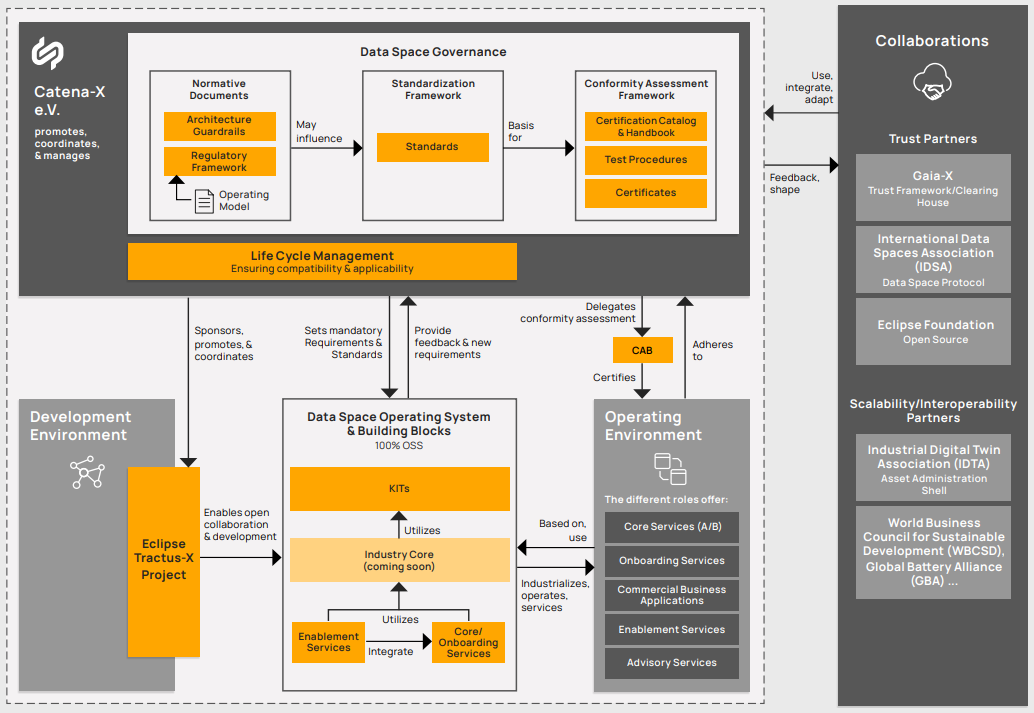Why: Understanding the Catena-X Data Space
Conceptual Foundations of the Catena-X Data Ecosystem
To comprehend the components that comprise the Catena-X operating model, it is necessary to have a basic understanding of the fundamental concepts that make up the Catena-X data ecosystem (see Figure Catena-X Data Ecosystem). The Catena-X data ecosystem consists of three areas: the Catena-X Automotive Network e. V., the development environment, and the operating environment.
 Catena-X Data Ecosystem
Catena-X Data Ecosystem
The Catena-X Automotive Network e. V. (in the following called “Catena-X Association” or “the Association”) is responsible for standardization, certifications, and governance of the Catena-X ecosystem. Members can participate in committees, working groups, and expert groups to actively shape the Catena-X ecosystem. The Catena-X Association publishes standards with the goal of enabling interoperability, data-sovereignty, and security for all participants in the data space. The ecosystem participants must comply with the standards published by the Catena-X Association to work with the data space. Catena-X standards build on Gaia-X/Inter-national Data Space Association (IDSA) concepts and principles, industry standards, and best practices, among others, and extends these by automotive domain and use case-specific requirements. By certifying ecosystem participants and software components, the Catena-X Association ensures transparency and trust in the eco- system. A certification testifies, for example, that a software component is interoperable, data sovereign, and safe to use in the Catena-X data space. The Association is complemented by the development environment. The focus of the development environment is on the one hand on the creation of standardization candidates that can be submitted into the standardization process of the association. And on the other hand, the development of open-source reference implementations and other implementations for the data space. In the operating environment, the various open-source and commercial services and business applications are operated by different providers. A detailed description of the provider roles and the associated software components can be found in Chapter Who: Roles in the Catena-X Ecosystem and Chapter What: Service Map. All three components jointly make up the Catena-X data ecosystem. In the following chapters, the roles, responsibilities, and functions of these components are described in detail.
The Catena-X Data Ecosystem Architecture
Underlining the Catena-X data ecosystem’s conceptual foundations are its individual data space components. Together, these building blocks serve as the architecture of the Catena-X data space, where each building block serves a dedicated purpose in one or several of the above-mentioned conceptual elements. An overview is depicted in Figure Catena-X Data Ecosystem followed by a short description of the main building blocks.
 Catena-X Data Ecosystem
Catena-X Data Ecosystem
The global Catena-X data space is built on 5 mission-critical pillars:
- a dedicated role concept covering all data space participants (see Chapter Who: Roles in the Catena-X Ecosystem)
- a Service Map of foundational software services, building blocks, and standards that form the Catena-X Operating System and Business Foundation (see Chapter What: Service Map),
- procedures, processes, and building blocks for a trusted, scalable, and compliant data space operation (see Chapter How: Data Space Operations),
- effective data space governance incl. standards, legal frameworks, (flight models) and certification (see Chapter How: Data Space Governance)
- an integrated and holistic life cycle management ensuring compliance, interoperability, and compatibility (see Chapter How: Life Cycle Management)
To promote adoption and collaboration, the Catena-X data space is built upon open-source principals, under the umbrella of the Eclipse Foundation. All Catena-X reference implementations and KITs are licensed under Apache 2.0 and CY BB 4.0. In order to structure and guide the development in open-source, Catena-X installed Organizational Elements (e.g., committees in the Catena-X Association), created a working group and project in Eclipse Tractus-X and defined a scalable structure for a business-oriented development and adoption of relevant artifacts and SW codes:
- Enablement Services
- Core Services
- Industry Core
- and use case KITs
With regard to standardization, the Catena-X Association promotes, sponsors and coordinates the overarching requirements of the Eclipse Tractus-X project. Standards are always linked, structured, and offered within those four elements.
Catena-X offers use case KITs to enable a multi-vender ecosystem of software solutions and services for each Catena-X use case. Solution and Service providers can create interoperable and data sovereign solutions and trusted services based on the Catena-X KITs and offer them on trusted marketplaces within the Catena-X Data Space (-> Core Service Provider A). The marketplaces are certified marketplaces that offer interoperable solutions from different solutions providers. The Core Services as well as marketplaces are part of the cxOS and are operated by certified operating companies (see Figure Service Map). With this comprehensive solution portfolio, players in the automotive value chain can create business value by establishing data-driven use cases and data chains.
Trust and conformity (of Services, Offers, and potentially other non-automotive data spaces) are fundamental for Catena-X’s acceptance, scalability, and value creation. Therefore, Catena-X chose and installed various neutral governance bodies – covering development and operation. The following partnerships and components in sum ensure a global data space built by best-in-class experts on trusted principles:
-
Gaia-X is the basis for our overarching Trust Framework and forms the foundation for a federated, interoperable data space with trusted identities.
-
The International Data Space Association (IDSA) provides architecture principles that enable sovereign data exchange.
-
The Eclipse Foundation hosts the official open-source development project of the Catena-X ecosystem and follows the Eclipse Foundation’s trusted development process.
-
The Catena-X Association provides industry-specific governance for the ecosystem that equally reflects the diverse interest groups within the automotive industry to serve common business needs. It also defines the vision, mission, and guiding principles for the Catena-X data space through the governance framework based on the Catena-X Statutes.
More specifically, in the Catena-X operating environment, the Catena-X Regulatory Framework for Data Space operations acts as a reliable mutual foundation to ensure trust, interoperability and therefore scalability. Catena-X’s success largely depends on trust that every participant plays by the same, commonly set rules. By standardizing many of the relationships and agreements necessary for data exchange and bringing Catena-X use cases to life, data space participants can put their focus largely on their individual business needs rather than individual contract negotiation between business partners. Through collectively approved guidelines and templates, data exchanges on Catena-X can be seamlessly executed and operated without friction.